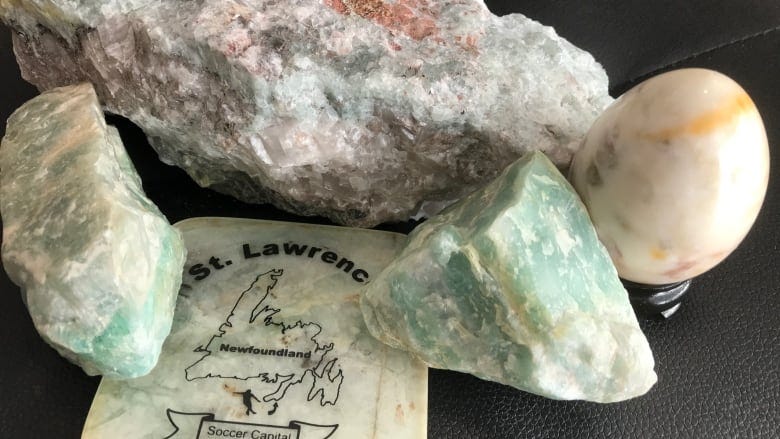Atomic Bomb Materials came from Newfoundland
Newfoundland played a role in the creation of the first atomic bomb by supplying a crucial ingredient, Fluorite, for its development. The necessary raw materials are said to be sourced from mining operations in St. Lawrence and Placentia.
Operations at the mine have since been halted and ownership has been transferred. There have been many noted cases of illness related to working the mines.

Possible German U-boat Wreckage discovered in Churchill River
In the Spring of 2010, The Stephen Hopkins Foundation were conducting a side-scan sonar while exploring beneath Churchill River during a recovery search and stumbled upon the an interesting wreckage. Intrigued, they later employed sonar technology to identify and capture images of the possible German U-Boat. The Foundation later reported their findings to the Receiver of Wrecks at Transport Canada.
Ray Tremblay of Mine EOD was later contracted by the Government to explore and investigate the wreck in 2014. The initial expedition didn’t produce any evidence as there was complete darkness and unpredictable water movement. They later filed 60 hours of footage and captured photographs of the wreckage. They also advised the Canadian Federal Government and German Embassy of the investigation. Ray Tremblay later noted in an email to the Provincial Archeologist that during his expedition in August 2014, they identified a propeller with a surface camera and noted the exact GPS position.
The wreck has not been confirmed or denied as an actual German U-boat.
If this discovery is proven to be a German U-boat used in WWII, it would be the farthest voyage into North American waters by a German U-boat. The Aurora, a Labrador newspaper, has talked about rumors that German U-boats came into the inlet, maybe to check out the massive Allied airbase at Happy Valley-Goose Bay.
Folklore has circulated throughout Labrador for decades about a silent, elongated shadow gliding up the river during the wartimes. Narratives also circulated about locals while camping close to the Churchill River during the same time period, claim to have heard engines roaring in the dead of night. Tales unfolded describing numerous uniformed men conversing in various languages or remaining tight-lipped when spoken to. Many from Labrador still maintain that the mysterious discovered object is a indeed Nazi U-boat that slipped into the inlet during the early 1940s and was somehow lost in time.
This idea is not outlandish when you think about how many of Hitler's U-boats were active along the eastern seaboard and in the Gulf of the St. Lawrence during World War II.
You can get your fill of information about the discovered wreck, although mostly repetitive, in the news articles linked below:
https://www.cbc.ca/news/canada/newfoundland-labrador/german-u-boat-may-be-at-bottom-of-labrador-river-1.1164735
https://www.cbc.ca/news/canada/newfoundland-labrador/u-boat-search-in-labrador-river-remains-murky-1.1164732#:~:text=The%20theory%20that%20a%20buried,anything%20to%20disprove%20the%20theory
https://www.thestar.com/news/canada/german-u-boat-wreck-may-be-at-bottom-of-churchill-river-in-labrador/article_961af30b-578b-55b0-a284-a49c115a62d4.html
https://nationalpost.com/news/canada/search-team-returning-to-churchill-river-after-release-of-sonar-images-showing-suspected-nazi-submarine
https://legionmagazine.com/probable-find-of-u-boat-in-the-churchill-river/
https://www.dailymail.co.uk/news/article-2180022/Does-grainy-sonar-image-sunken-German-U-boat-river-200-miles-coast-Newfoundland.html
I stumbled across an intriguing blogpost you can read in full here. In summary, a theory was mentioned that stuck out to me in particular. Not only is there possibly a German U-boat imbedded beneath Churchill River but there may be two. The vessels were possibly scuttled intentional by the US Military after taken over the vessel proceeding surrender. The theory suggests that German U-boats, specifically U-180 and U-851, secretly transported uranium to the US during World War II. The author posits that these U-boats laid near Muskrat Falls and, after delivering uranium to the U.S. base in Goose Bay, Labrador, proceeded up the Churchill River to scuttle their U-boats. The theory argues that this inland route was strategically risky, and the purpose was not just to avoid the war but to strike a secret conditional surrender. The alleged deal involved providing uranium, technology, and scientists to the US in exchange for post-war protection of German corporations and Nazi figures, including possibly Hitler. The theory suggests that this alliance aimed at fighting the Soviet Union and shaping the post-war world order. U-180 and U-851 supposedly carried secret cargos to Japan, with U-180 transporting uranium and U-851's payload remaining unconfirmed. Both U-boats disappeared in late summer and early fall of 1944, maintaining radio silence during their journeys. The theory is supported by the documentary "Hitler's Last U-boat," focusing on U-234, which deliberately surrendered to the US and also carried uranium.
It's hard to visualize the U-boat wreck Mr. Tremblay has discovered as neither he nor the government will allow any pictures of it to be released. He told me the wreck is approximately 68 meters long and he believes it to be an intact type VII German U-boat. He remains completely committed and determined to be the one that exposes it once and for all, and given his work and financing of the project that should never be denied to him. that being said, as a point of history, the government and or Mr. Tremblay should release the images of the U-boat wreck so that the people of the province, and Germany, can see it once and for all. In addition, those of us with experience in identifying these sort of things may well be able to identify the boat's type by its distinctive structures. I don't believe that would in any way take away from Mr. Tremblay's exclusive claim to having discovered the wreck - it would simply share the images of it with the rest of us. For history's sake.
The uranium originally carried on German U-boat 234 was intended to be used for German allied Japan's defense but ended up being used against Japan, as the United States dropped the first atomic bomb on Hiroshima.
U-Boat 180
Keep reading with a 7-day free trial
Subscribe to The Newfoundland History Sleuth to keep reading this post and get 7 days of free access to the full post archives.










